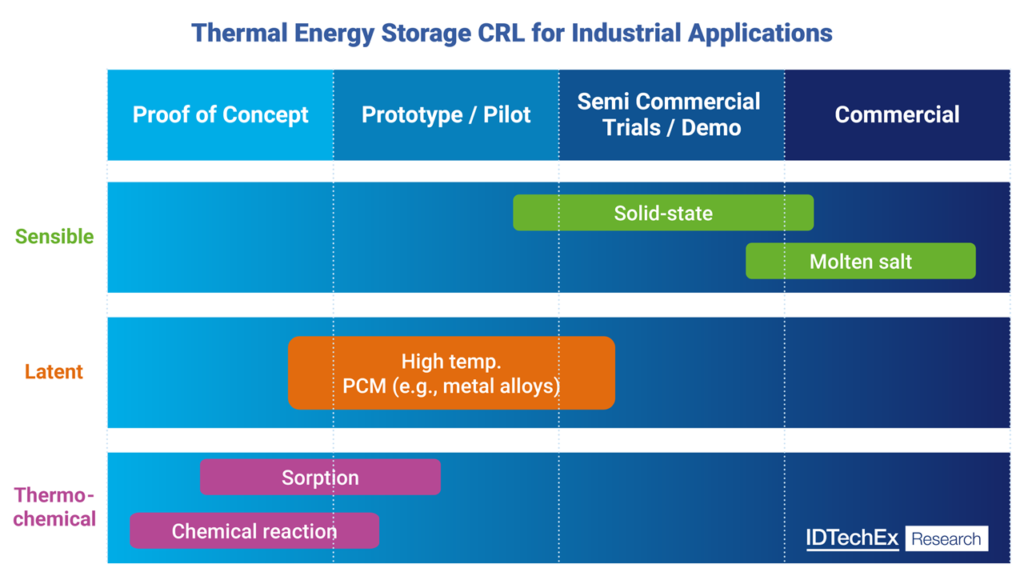Heating and cooling accounts for approximately 50% of global energy consumption, with 30% of this consumption represented by heating demand from industry. Given that the great majority of industrial heating processes use fossil fuels to generate heat, this has caused industrial heating processes to be responsible for ~25% of global emissions. Government initiatives have been established in key regions to accelerate the development of industrial decarbonization technologies, including carbon capture and storage (CCUS), heat pumps, and thermal energy storage (TES), among more direct electrification technologies. From their new market report, “Thermal Energy Storage 2024-2034: Technologies, Players, Markets, and Forecasts”, IDTechEx forecasts that over 40 GWh of TES capacity is expected to be installed across industry in 2034.
An Emerging Market for Thermal Energy Storage
TES technologies have been widely deployed in various applications and markets, including pairing with concentrated solar power (CSP) plants, district heating, cold chain, and space heating for buildings. Their penetration in the industrial sector is far lower, with only ~1% of global TES capacity being represented by systems installed in industrial environments. As governments are looking to reduce emissions from industry to help reach wider net-zero targets, the proportion of global TES capacity represented by industrial deployments is expected to increase. Given the vast array of industrial heating processes, it is important to examine the different TES technologies being developed by key players and how system designs and levels of commercialization will influence their uptake in industry.
Key Industrial Thermal Energy Storage Players and Technologies
Most industrial TES players are dispersed across Europe, the US, and Australia. As shown in IDTechEx’s market report, these players are developing and commercializing both sensible heat and latent heat TES systems for industrial applications, with most having deployed pilot or commercial demonstration projects.

A sensible heat TES system would see a thermal storage medium, such as molten salt, concrete, or refractory brick, being heated up to a higher temperature, storing this heat until it is later needed, and transferring this heat on discharge to an industrial process. Heat can be transferred to a heat transfer fluid (HTF), such as water, air, or thermal oil. Latent heat systems will see a phase change material (PCM), such as a metal alloy or silicon, being heated at constant temperature to change its phase from solid to liquid.
Latent Heat Thermal Energy Storage
Latent heat systems can exhibit higher energy storage densities than sensible heat systems, given that a large amount of heat is needed to change the phase of a material from solid to liquid. This could be useful in industry where existing manufacturing environments may already be spatially constrained. Another advantage of latent heat systems is their ability to supply heat at a constant temperature, given that they can work under isothermal conditions. This is important for industrial processes that seek the supply of heat at constant working parameters, i.e., temperature, pressure, and/or flow rate.
However, the containment of PCMs and variation in material properties under extended cycling are factors that require further development if latent heat systems are to have longer lifetimes or fewer material replacements over the course of the system’s lifetime. Moreover, a fewer number of key players are developing latent heat systems compared to sensible heat systems, with one example being 1414 Degrees in Australia developing a silicon-based latent heat TES technology. Such factors will likely lead to a lower level of commercial-scale latent heat TES deployments in the medium term.
Sensible Heat Thermal Energy Storage
Molten salt TES technologies have been widely deployed in CSP applications, and this has likely spurred their commercial uptake in industry sooner than other TES technologies. However, on discharge, the temperature of thermal storage media used in sensible heat systems decreases, which, without further system design, would result in varying temperatures being supplied to an industrial process, which would be unfeasible or at least undesirable.
Molten salt systems, such as those developed by Norwegian-based player Kyoto Group, can work around this issue by incorporating continuous recirculation loops, which would keep the salt within its working temperature range while still providing heat at constant temperature to an industrial process. A key downside to molten salt TES is that these systems cannot store heat at temperatures above 600°C due to salt decomposition occurring. This limits the application cases of this technology, though these technologies will still be in demand for lower- and medium-temperature industrial processes such as drying and process fluid heating.
Solid-state sensible heat systems use materials such as concrete and refractory brick and are being developed by key players such as EnergyNest and Rondo Energy. A solid-state system that provides hot air to a process could be blended with an ambient or cooler air stream on discharge, with varying ratios over time such that the air is supplied to a process at a constant temperature. This will, however, increase system complexity and cost. Importantly, solid-state systems can promise the supply of higher temperature heat above 1,000°C, which will be crucial for the decarbonization of certain glass, metal, and cement manufacturing processes.
Future Thermal Energy Storage Technology Outlook
Crucially, many of the solid-state TES technologies being developed still struggle to supply heat temperatures exceeding 1,300°C due to limitations of materials’ mechanical and thermal stability, and that to supply heat at constant temperatures, cooler fluids may need to be blended with hotter fluids leaving the system on discharge. Therefore, the development of novel materials or the alteration of material compositions will be needed to decarbonize some of the highest-temperature industrial heating applications, including some metal heat treating and melting processes. One key player, Electrified Thermal Solutions, based in the US, is developing a TES technology adopting electrically conductive ceramic bricks. These bricks have had their chemical composition altered such that they are able to take electricity as an energy input and have them double up as a heating element, storing the heat generated from electricity. A furnace could be constructed out of the bricks to provide radiative heat directly to a process, potentially up to 1,800°C. This would allow the decarbonization of some of the more extreme industrial heating processes seen in metal and glass industries.
Further, in the future, it is possible that thermochemical energy storage (TCES) technologies could penetrate the market. These technologies can either make use of sorption (adsorption or absorption) between two materials or chemical reactions to store energy as chemical potential. These systems have higher theoretical energy densities and lower heat loss over time than latent heat and sensible heat systems. This could make them suitable for future residential and seasonal storage applications. A number of TCES prototypes have been created, though the vast number of material combinations that could hypothetically be used in such systems may be a hindrance to the commercial development of any one TCES technology. Fine optimization, greater awareness, and funding for these technologies are needed to bring them to market.

Over the next decade, as suggested in IDTechEx’s market report, sensible heat systems are expected to dominate the industrial TES market. Their use of abundant and low-cost materials, while being able to provide heat over 1,000°C in the case of solid-state systems, makes them suitable technologies for a wide range of industrial heating applications. Further development of latent heat and TCES technologies for decarbonized industrial heating is expected, though wider markets and applications could benefit from using such systems which suppose higher energy densities.
For more detailed information on thermal energy storage technologies and benchmarking analysis, key players, strategic partnerships, applications, projects, markets, government initiatives, drivers, and granular 10-year market forecasts, please refer to IDTechEx’s new market report “Thermal Energy Storage 2024-2034: Technologies, Players, Markets, and Forecasts”.

















